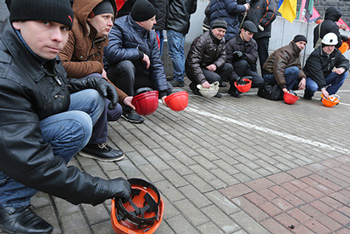

Vol. 79/No. 5 February 16, 2015

|
| Miners from across Ukraine demand unpaid wages and end to mine closures Jan. 28 in Kiev. Miners pound hats, hallmark of 1989-91 strikes that helped win Ukraine independence. |
Miners banged their helmets on the wall and the streets outside the Cabinet of Ministers, an action reminiscent of the 1989-91 wave of strikes and protests by miners. These mobilizations, which combined demands for higher pay and better conditions with political demands, including an end to Russian domination, helped prepare the way for an independent Ukraine. The Independent Trade Union of Miners of Ukraine (NPGU) was born out of those actions, as an alternative to the official unions, which were tied to the Soviet government.
The Jan. 28-29 protests included many members of the NPGU, as well as a delegation from the Dnepropetrovsk Territorial Union of the Coal-Mining Industry of Ukraine, affiliated to the official Federation of Trade Unions.
Their central demand was that the government drop plans to close more mines and invest the necessary resources to keep them running. “Of the 150 coal mines in Ukraine 115 are in areas now controlled by separatist forces,” Mykhailo Volynets, chair of the Independent Trade Union of Miners, told the Militant. “Only 20 of the remaining 35 mines are operating, and the government plans to close those that remain under state ownership,” a “market reform” demanded by the International Monetary Fund as a condition for loans to Kiev.
“There are a lot of our miners who are fighting for independence and freedom in Ukraine,” Mykola Volynko, chair of another independent miners’ union in Donbass, told the rally, but the government “continues to destroy the industry.”
Demonstrators protested government purchases of coal from South Africa and Russia to keep electrical plants operating, while mines in Ukraine are shuttered and miners laid off.
Those who are working are owed up to six months’ back pay. Workers from the Lviv Coal Processing Plant said they only received half of their salary for December. “The government does not understand that every home is lit and heated thanks to the hard work of miners,” Olga Shkoropad, president of the NPGU local at the Lviv plant, told the rally.
The miners suspended their protest Jan. 29 after Vladimir Demchishin, the minister of energy and coal, promised they will receive half of the back wages in the next few days and the rest within two weeks. A commission to negotiate the miners’ demands was set up, including union representatives, government officials and representatives of the private DTEK mines, owned by Ukraine’s richest capitalist, Rinat Akhmetov. The miners say they are prepared to return to Kiev if necessary.
Workers bear brunt of war in east
The escalating war with separatist forces in the eastern regions of Donetsk and Luhansk is taking a toll on working people on both sides of the battle lines. Twelve residents died Jan. 31 from shelling in Debaltseve, the last government-held town on the road between the cities of Donetsk and Luhansk. The town has been without electricity, water and gas for at least 10 days, and thousands of the remaining residents are being evacuated. Debaltseve is surrounded by separatist forces on three sides, so those fleeing must travel along a narrow corridor that’s subject to shelling.
At least a dozen civilians were killed Jan. 30 in the city of Donetsk, which is now completely controlled by the separatists. Five people died when rockets hit outside a community center where relief supplies were being distributed and hundreds of people had gathered.
Both the Ukrainian army and separatist forces use Grad missiles, which are notoriously inaccurate.
The separatists began taking over government buildings and industrial workplaces in eastern Ukraine in the wake of the mass popular mobilizations that toppled the pro-Moscow government of Viktor Yanukovych in February 2014. Proclaiming themselves the “People’s Republic of Donetsk” and the “People’s Republic of Luhansk,” the separatists have received heavy weapons and fighters from Moscow.
Kiev has tightened its checkpoints to further restrict movement in and out of separatist-controlled areas. Anyone wishing to cross has to apply for a permit, which takes 10 days to process and is often denied. Many workers living in the separatist areas were regularly crossing to access bank accounts and pensions on the government-controlled side. Others travel into the separatist areas to bring supplies to relatives and friends. This traffic has dropped nearly 90 percent since the new passes went into effect in mid-January.
The separatist leaders recently legalized small, privately run mines known as kopanki, as long as the operators pay taxes to the People’s Republic of Donetsk. Many of these operations — often no more than a backyard pit — were started in the 1990s by workers trying to get some fuel for their families, but have since grown into big, lucrative and illegal businesses. “These mines are extremely dangerous,” Volynets told the Militant. “Miners have no safety gear, they are paid off the books so they have no pensions or disability benefits if they are injured.”
Related articles:
Nat’l oil workers strike fights for job safety
Walkout at 9 refineries largest since 1980
On the Picket Line
Workers fight frame-up for Lac-Mégantic rail disaster
Membership drop poses need to rebuild unions
1978 disasters show danger from rail bosses’ drive for profit
Front page (for this issue) |
Home |
Text-version home